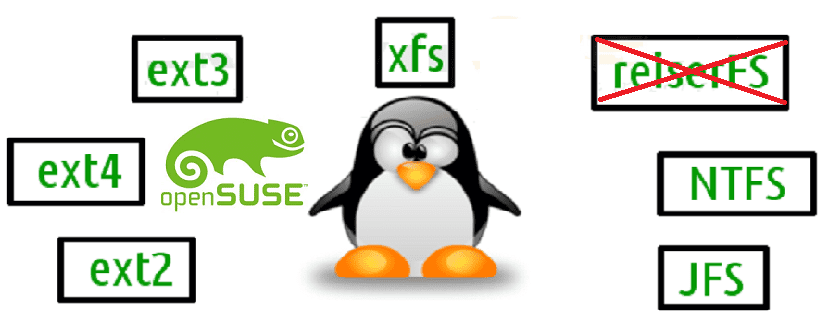
EXT4, XFS, BTRFS and Bcachefs: Which one to use in the year 2024?
A few months ago, in a previous post, we talk about the current state and news of the modern and innovative Bcachefs file system. Which, Bcachefs is a general purpose file system, which uses the copy on write system (Copy On Write / COW) descendant of bcache, a block layer cache, and whose internal architecture is very different from most existing file systems. Since, it is designed more like a file system on a relational database, with tables for the different types of file system data.
And since, also almost 4 years ago, we addressed what file system should we choose for our disks and partitions with operating systems based on GNU/Linux, today we will take the opportunity to offer you a similar publication. One where we include the characteristics and news of the 4 most prominent and used in the year 2024, which are: «EXT4, XFS, BTRFS and Bcachefs ».

File systems: which one to choose for my disks and partitions in Linux?
But, before starting this present publication on «EXT4, XFS, BTRFS and Bcachefs », which are 4 of the most prominent and used file systems in the year 2024, we recommend exploring a previous related post with this type of elements within free and open operating systems:


EXT4, XFS, BTRFS and Bcachefs: Which one to use in the year 2024?
Current features of EXT4, XFS, BTRFS and Bcachefs
EXT4
- Official and trustworthy websites: The Kernel.org Documentation and Kernel.org Wiki.
- brief description: EXT4 is an advanced level of the EXT3 file system that incorporates scalability and reliability improvements to support large file systems (64-bit) in line with increasing disk capacities and the state of current technical features and requirements. .
7 Current Featured Features
- Adds internal redundancy in the file system tree.
- It has the ability to use file systems larger than 16 TB.
- Adds journal checksum functions for greater robustness and performance.
- Supports case-insensitive file name searches.
- Its extension format reduces metadata overhead (RAM, I/O for access, transactions) and being more robust compared to EXT3, it is better against disk corruption due to failures.
- Provides support for large files and large blocks (up to page size). In addition, support for file-based encryption (FSCcrypt) and file-based Verity (FSVERITY).
- It includes improved file allocation (multi-block allocation) and persistent file pre-allocation, which is ideal for streaming media, databases, and other important items.
You are and others New features recently added make it ideal for use on home computers and office users, which do not require intensive use of the File System. Its good features and functionalities are sufficient for the largest number of users and uses of a computer with average uses, that is, normal ones. Although, its use in servers with low demand or operation is also excellent.
XFS
- Official and trustworthy websites: The Kernel.org Documentation and Kernel.org Wiki.
- brief description: XFS is a high-performance journal file system that originated on the SGI IRIX platform. It is completely multi-threaded, can support large files and large file systems, extended attributes, variable block sizes, and in addition, is extension based and makes extensive use of Btrees (directories, extensions, free space) to help both performance and scalability.
7 Current Featured Features
- It is a high-performance file system that has gained popularity for its scalability and robustness.
- Over the last few years, it has undergone significant development and optimization, and integration into the Linux Kernel.
- At the Scalability level, it excels in large-scale storage scenarios, making it ideal for enterprise-level storage solutions.
- At the Performance level it offers improved capabilities for large files, that is, it is better optimized to handle large files and high-performance workloads, making it the best option for multimedia and data-intensive applications.
- At the Metadata Management level, it manages metadata efficiently, reducing bottlenecks and improving overall performance.
- It is ideal for work environments that demand massive storage capacity and high performance, such as data centers, media production, and scientific computing.
- Despite offering unparalleled scalability and performance, it may not be the best choice for small-scale systems or those that require advanced features such as snapshots and built-in redundancy.
You are and Other features that are constantly added make it ideal for use on Servers, especially of high demand or operation, which require intensive use of the file system and more robust mechanisms for the recovery of the same and the data contained. In other words, Servers that handle a large disk read / write load, standalone type databases or manage shared webhosting operations, among other applications.
BTRFS
- Official and trustworthy websites: The Kernel.org Documentation and Official documentation.
- brief description: BTRFS is a modern copy-on-write (COW) file system for Linux that aims to implement advanced features while focusing on fault tolerance, repair, and ease of management.
7 Current Featured Features
- Allows extension-based file storage (maximum file size 2^64)
- It offers a small file and indexed Directory packaging format that saves space compared to other current FS.
- It offers dynamic inode allocation, snapshots, writables, subvolumes (separate internal roots of the file system), and object-level imaging and striping.
- Adds data and metadata checksums (multiple algorithms available), Compression (multiple algorithms available), and Reflink, deduplication, and Scrub (online checksum verification) functions.
- Supports the use of hierarchical quota groups (support for subvolumes and snapshots) and Incremental Backup and FS Mirroring (send/receive).
- Includes built-in support for multiple devices, and multiple RAID algorithms. And also, reviewing and defragmenting the offline file system and read/write metadata.
- It uses CoW to ensure data integrity and enable efficient snapshotting, making it a powerful tool for data management. Additionally, it includes RAID-like functionality and snapshots, which simplifies data protection and recovery, and enables online repair and maintenance operations, minimizing downtime.
You are and other features in progress make it ideal for use in high-performance Workstations and Servers. Since, it stands out for its excellent capabilities, especially the advanced ones that, in general, go beyond simply improving performance, that is, they are more focused on storage management and security.
Bcachefs
- Official and trustworthy websites: Its Official website .
- brief description: BTRFS is a modern copy-on-write (COW) file system for Linux that aims to implement advanced features while focusing on fault tolerance, repair, and ease of management.
7 Current Featured Features
- Bcachefs emphasizes reliability and robustness, along with high throughput and low tail latency.
- Like, BTRFS or ZFS file systems implement Copy on Write (COW).
- Provides full checksum implementation of data and metadata, handling of multiple devices.
- Supports Replication, Compression, Encryption, Snapshots and Nocow Mode functions.
- It offers erasure coding features (unstablely, for now).
- Supports data caching and placement. In addition to, extended attributes, ACLs and quotas.
- It is scalable. To date, it has been tested efficiently handling more than 100 TB, and is expected to scale further.
Like, BTRFS, its current characteristics and in full development make it ideal for use in high-performance Workstations and Servers. Since, its objective is to prioritize robustness and reliability over performance, in order to ensure that data managed by it is not lost.


Summary
In summary, we hope that you find these features and current news, and the official and reliable sources of information on these 4 of the most important types of file systems, whose names are useful and interesting. «EXT4, XFS, BTRFS and Bcachefs ». Above all, when it comes to wanting or needing to choose, appropriately or correctly, the one that best adapts or suits your type of hardware and its use.
Lastly, remember visit our «homepage» en español. Or, in any other language (just by adding 2 letters to the end of our current URL, for example: ar, de, en, fr, ja, pt and ru, among many others) to find out more current content. Additionally, we invite you to join our official telegram channel to read and share more news, guides and tutorials from our website. And also, the next Alternative Telegram channel to learn more about the Linuxverse in general.